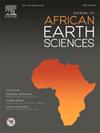阿尔及利亚东北部Batna山脉晚Cenomanian neolobite vibrayeanus生物事件的群落结构
IF 2.2
4区 地球科学
Q2 GEOSCIENCES, MULTIDISCIPLINARY
引用次数: 0
摘要
新石虫(Neolobites vibrayeanus, d'Orbigny)是发生在北非和中东地区的著名生物事件。相当于Cenomanian早-晚Calyoceras guerangeri生物区(~ 95.2-94.8;my = 400ky)。这一年代久远的事件被用来分析阿尔及利亚巴特纳山脉大型底栖动物群落的微小变化。在研究区,新石器生物事件常伴有鹦鹉螺(Coquand)。对四个断面底栖动物群落的定量分析表明,大底栖动物群落的组成和功能在逐渐变化。这些垂直的动物群变化与四阶(20米厚)沉积旋回的放养模式相吻合。表层动物和悬浮食性动物数量逐渐减少,并在最大洪泛面(mfs)处达到最小值,而内部动物和沉积物食性动物如不规则棘虫增加,并在最大洪泛面(mfs)处达到峰值。多样性指数呈逐渐下降趋势,优势度呈上升趋势,这主要归因于不规则棘类植物的深入、繁盛和推土机活动的增加。这些活动可能导致了一个软底,在那里,脚底上的分类群受到了负面影响。与显著的垂直区系变化相比,地理变化较小,表明相似环境背景的横向程度,因此,该生物事件的地层特征是同时记录的。我们的分析表明,动物转移延伸到层序边界之外,特别是在TST晚期和HST早期,突出了生物层序地层学在低能量环境中最小的岩相变化的有效性。本文章由计算机程序翻译,如有差异,请以英文原文为准。
Community structure of the late Cenomanian Neolobites vibrayeanus bioevent in the Batna Mountains (Northeastern Algeria)
Neolobites vibrayeanus (d'Orbigny) is a well-known bioevent in North Africa and the Middle East. It is equivalents to the marker early-late Cenomanian Calyoceras guerangeri biozone (∼95.2–94.8; my = 400ky). This well-dated event was used to analyze minor variations in the macrobenthic communities within Algeria's Batna Mountains. In the study area, the Neolobites bioevent is often accompanied by the nautiloid Angulithes mermeti (Coquand). Quantitative analyses of the benthic fauna from four sections indicated gradual changes in the composition and function of the macrobenthic faunal community. These vertical faunal changes coincide with the stocking pattern of a fourth-order (20-m thick) depositional cycle. Epifauna and suspension feeders decreased gradually and reached a minimum at the maximum flooding surface (mfs), while infauna and deposit-feeders such as irregular echinoids increased and reached a peak at the mfs. Diversity indices show gradual biodiversity decrease and dominance increase upward, which was attributed to deepening, flourishing of the irregular echinoids, and increasing bulldozing activities. These activities may have resulted in a soft substrate, where epifaunal taxa were negatively affected. In contrast to significant vertical faunal changes, geographic variations were minor suggesting lateral extent of similar environmental setting, and thus, the stratigraphic features of this bioevent have been simultaneously recorded. Our analysis reveals that faunal shifts extend beyond sequence boundaries, particularly during late TST and early HST, highlighting the effectiveness of biosequence stratigraphy in low-energy environments with minimal lithofacies variation.
求助全文
通过发布文献求助,成功后即可免费获取论文全文。
去求助
来源期刊

Journal of African Earth Sciences
地学-地球科学综合
CiteScore
4.70
自引率
4.30%
发文量
240
审稿时长
12 months
期刊介绍:
The Journal of African Earth Sciences sees itself as the prime geological journal for all aspects of the Earth Sciences about the African plate. Papers dealing with peripheral areas are welcome if they demonstrate a tight link with Africa.
The Journal publishes high quality, peer-reviewed scientific papers. It is devoted primarily to research papers but short communications relating to new developments of broad interest, reviews and book reviews will also be considered. Papers must have international appeal and should present work of more regional than local significance and dealing with well identified and justified scientific questions. Specialised technical papers, analytical or exploration reports must be avoided. Papers on applied geology should preferably be linked to such core disciplines and must be addressed to a more general geoscientific audience.
 求助内容:
求助内容: 应助结果提醒方式:
应助结果提醒方式:


